BY SELMIN KARA
Alfonso Cuarón’s sci-fi thriller Gravity (2013) introduced to the big screen a quintessentially 21st-century villain: space debris. The spectacle of high-velocity 3D detritus raging past terror-struck, puny-looking astronauts stranded in space turned the Earth’s orbit into not only a site of horror but also a wasteland of hyperobjects,[1] with discarded electronics and satellite parts threatening everything that lies in the path of their ballistic whirl (see Figure 1). While the film made no environmental commentary on the long-term effect of space debris on communication systems or the broader ecological problem of long-lasting waste materials, it nevertheless projected a harrowing vision of technological breakdown, which found a thrilling articulation in the projectile aesthetics of stereoscopic cinema.
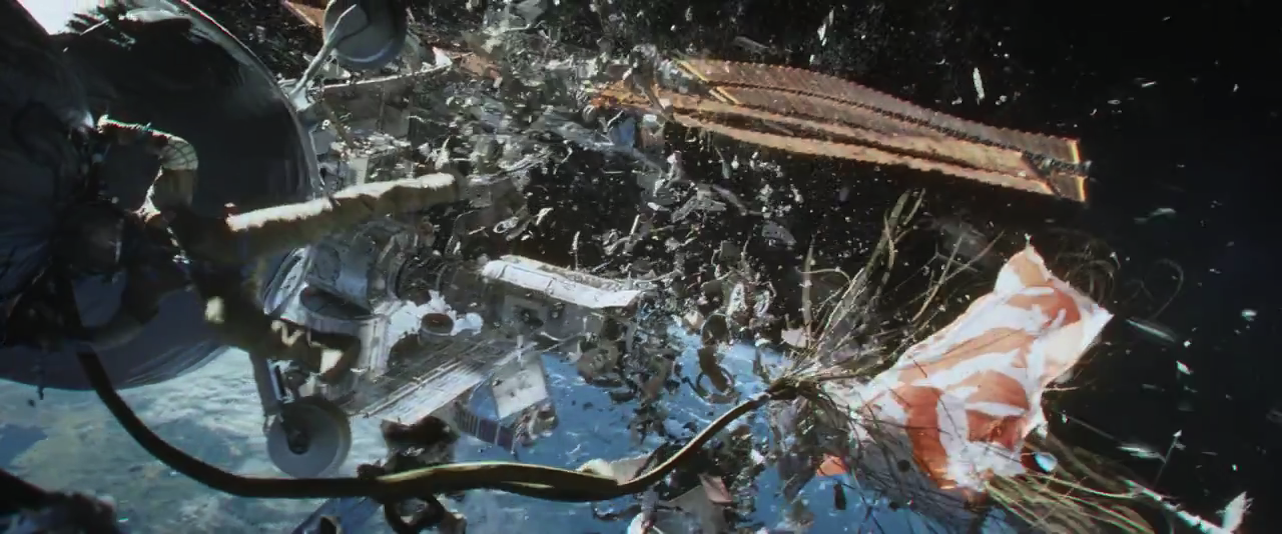
In the same year, techno-industrial waste made another center-stage appearance in South Korean filmmaker Bong Joon-ho’s international sci-fi film Snowpiercer (2013), this time as an anarchic agent of revolution. Snowpiercer depicts the class struggles among the survivors of an accidental ice age triggered by a human experiment aimed at counteracting global warming, but which left the remnants of humanity confined to the claustrophobic space of a train ceaselessly circling the globe. The cruelty of the technofixes put in effect in order to maintain the carefully bio-engineered mini-ecosystem on board the train eventually lead to a revolt. The revolutionary cause calls for extreme measures, thus prompting one of the main characters to fashion a bomb out of the highly addictive and also highly combustible drug Kronol, which is made of industrial waste. The bomb annihilates (almost) everyone aboard the train—which is to say: nearly all of humanity.
What seems to be common to the imaginations of hyper-scale waste—or “waste fantasies” (Lynch)—in these two films is a contemporary aesthetic reminiscent of accelerationism, which as a critical strategy in the realm of art refers to the attempted intensification and creative destruction of the conditions of global neoliberal capitalism by stretching it to (and ideally beyond) its limits. But if there are any accelerationist undertones in Gravity and Snowpiercer, they do not serve a clearly critical agenda, thus recalling the manner in which Steven Shaviro frames the accelerationist aesthetics of films like Mark Neveldine and Brian Taylor’s Gamer or Alex Cox’s I’m a Juvenile Delinquent, Jail Me! (“Accelerationist”). Shaviro argues that accelerationist art today works best when it does not claim a political efficacy, since “[i]ntensifying the horrors of contemporary capitalism does not lead them to explode; but it does offer us a kind of satisfaction and relief, by telling us that we have finally hit bottom, finally realized the worst.” The depictions of acceleration in Gravity and Snowpiercer (the audiovisual intensification provided by the dizzying orbits of space debris and a high-speed train, both leading to spectacles of destruction) are pleasurable precisely in this non-cathartic manner. They stretch environmental threats to their limits, yet their final acts offer no closure or definite salvation for the characters or for humanity. Instead of focusing on the films’ accelerationist tendencies in this chapter, however, I would like to locate in them an alternative or concomitant aesthetic—an aesthetic of disposal, perhaps—one that sees in waste not just a new cinematic object but an event, consequently marking a shift in post-cinema towards new formulations of time and space brought about by the becoming-cinematic of the Anthropocene imaginary.
The concept of the Anthropocene has steadily gained traction over the past decade. It refers to the idea that human activities since the Industrial Revolution have led the Earth into a new geological epoch, in which humankind has played a decisive role in radically reshaping the world’s ecosystems, the biosphere, and even the geological record itself. The term was first coined (and largely forgotten) in the 1980s, only to be resurrected in 2000 by a group of scientists that included Paul Crutzen, Nobel laureate in atmospheric chemistry and Vice Chair of IGBP (International Geosphere-Biosphere Programme). With the efforts of global-change research programs like IGBP and IHDP (the International Human Dimensions Programme on Global Environmental Change), the concept was quickly adopted in scientific literature as well as in the humanities, giving researchers and scholars a common platform to discuss issues like global warming, environmental change, the acidification of the oceans, and the accelerating pace of anthropogenic (human-caused) mass extinctions.
The proliferation of films with ecological disaster and extinction narratives in recent years suggests that the Anthropocene might also signal a new epoch in the ecology and temporality of cinema. Through the aid of new technologies and CGI, films increasingly stretch the boundaries of cinematic time and space across deep pasts, vast futures, and previously unmappable topographies in order to project visions of humanity under constant threat by factors of its own making—including those “hyperobjects” which now outscale and will long outlast us. The imaginations of waste in Gravity and Snowpiercer are distinctive in this regard, in that they take up one of the most paradigmatic and troubling products of anthropogenic activity, and recycle its effects to make us consider cinema’s own threatened status in an age in which the traditional forms and technologies that we associate with film have become disposable or at least easily replaceable by emerging media.
The Right of Disposal
In Gravity, the portrayal of massively distributed space waste offers little philosophical or ecological insight into the extent of human influence on Earth and outer space. Instead, Mission Control explains it as the side effect of the Russians’ intentionally shooting down one of their own satellites, which has apparently “gone bad.” This prompts Lieutenant Matt Kowalski, played by George Clooney, to immediately affirm the situation as the Russians’ “right of disposal,” suggesting that he understands discarding defunct devices in the orbital region as a standard procedure. What is not so clear in the brief exchange between Mission Control and Kowalski is the appropriate response to the effects of space disposals: whether or not there are also standard procedures put in place for waste management.
The film’s science advisor Kevin Grazier acknowledges that the space debris chain-reaction story was based on the so-called Kessler Syndrome (O’Callaghan), a scenario proposed by NASA scientist Donald J. Kessler in 1978, stipulating that expired satellites and other space junk are bound to accumulate over time until cascading or chain collisions are inevitable.[2] Kessler himself appeared in the 2012 documentary Space Junk 3D, which sought to raise awareness about the growing problem of space debris. In contrast with the IMAX documentary, however, Gravity never questions the alleged inevitability of the scenario or its implications for the future, including the potential to render satellite connections, GPS systems, weather forecasts, and space exploration impossible for several generations. What prevails is a disaster film aesthetic that objectifies debris as side effect and spectacle. Computer-generated shards of techno-military hubris expand and collide in a perfect storm, making the film as much about the affect that the hyperrealism of this digital onslaught projects onto the bodies of the characters and the film’s viewers (this affect itself perhaps a massively distributed hyperobject) as it is about the somewhat melancholic survival story in the backdrop of the minimal narrative. However, an afterthought—or an after-affect—lingers once the protagonist manages to find her way back to the Earth, and the cloud of debris is left to drift aimlessly in the geostationary orbit offscreen and away from the sight and psyche of the spectator. Instead of offering a clear resolution, Cuarón’s peculiar ending to the film hints at a contamination of consciousness with hyper-waste’s drifting yet haunting presence, granting a cinematic resonance to environmental scholar Myra Hird’s statement, “Waste doesn’t really go away—it flows over time and through space” (105).
Gravity’s presumably triumphant final sequence shows the protagonist, astronaut Dr. Ryan Stone (played by Sandra Bullock), re-entering the atmosphere and finding the Earth in an edenic, almost primordial state. After freeing herself from the Shenzou escape pod that is submerged in the lake, she swims to the shallow edge and pulls herself up onto red rocks and mud (see Figure 2).

After a couple of trials, she succeeds in standing upright, which symbolizes her regained will to survive and evokes the primal scene of evolution. As the director describes in an interview:
She’s in these murky waters almost like an amniotic fluid or a primordial soup. In which you see amphibians swimming. She crawls out of the water, not unlike early creatures in evolution. And then she goes on all fours. And after going on all fours she’s a bit curved until she is completely erect. It was the evolution of life in one, quick shot. (Woerner)[3]
This reference to evolution and primordial times is significant in that the resolution of the narrative seems to involve an imaginary rewinding of civilization, rather than a more predictable ending in which Dr. Ryan Stone reaffirms or reclaims the life she left back home. Her survival is represented through a retreat, metaphorically, to the image of an almost nonhuman world, in which numerous factors that might lead the viewer to hold onto the anxiety of technological breakdown have been erased, including the traces of humanity itself. While such an ending encourages a survival-of-the-fittest Darwinian interpretation, it also associates the threat of technological breakdown with the threat posed more generally by “the human imprint” (Steffen et al. 842). Consequently, waste constitutes the exemplary abject object, easily and intentionally discarded from the narrative, but eliminable from the psyche only through a complete reboot of humanity.
Yet the final sequence also speaks to the liminal spatio-temporality of waste. In Waste: A Philosophy of Things, William Viney states that waste is always a product of time: “Since the advent of waste occurs in and through time, it provides us with an event that marks, measures, and transforms duration” (33). What Viney describes here is the duration involved in the process of decaying matter: when things get disposed, they slowly degenerate. However, Viney also addresses waste in the form of tools that no longer function and get discarded (invoking Heidegger’s analysis of the broken hammer), arguing that the failure of equipment discloses our existential relation with space, time, and being-in-the-world: “The advent of waste puts objects at a threshold by which pre-existing structures of meaning are called forth to expose their fragility.” (37) The chain reaction triggered by discarded electronics in Gravity points to a similar breach of threshold, existential crisis, or spatio-temporal disorientation.
While space debris is presented as the side effect of programmatic disposal, the astronauts and the spectator find themselves displaced amidst a chaotic whirl and grand-scale disintegration of matter, the beginning and end points of which cannot be clearly discerned. The closest reference point, the space junk’s foreseeable destination, is perhaps the farthest from human grasp and imagination; the waste that leaves the filmic frame is set to travel indefinitely in the vast stretches of cosmic space and time (thus giving offscreen space a cosmic spatio-temporality that defies easy representation).
However, it is equally difficult to imagine the point of origin of the satellite debris’ waste-event. The dysfunctional and discarded materials of the Russian satellite only constitute waste within the broader trajectory of space technologies’ planned obsolescence that preconditions their disposal. The emergence of international organizations like the Inter-Agency Space Debris Coordination Committee (IADC), the establishment of standard procedures for mitigating orbital debris, and the demarcation of zones known as the graveyard or junk orbit underscore the fact that space waste is now a well-recognized and highly regulated phenomenon. With regard to the Kessler scenario, one can even trace the waste-event back to the 20th-century industrialization-cum-militarization of space that led to the unsustainable proliferation of satellites in the first place. Lastly, though, waste in the larger context is inextricable from global neoliberal capitalism, which is predicated on “continual cycles of novelty and obsolescence” (Gabrys vii), further blurring the causal relations behind the satellite’s breakdown, procedural disposal, and the ensuing side effects in the film. What the final sequence of Gravity seems to suggest, through a return to the trope of evolution, is that the temporality of waste might even be linked more basically to the emergence and evolution of humans on Earth, therefore measuring it at a geological scale. Here, waste ceases to be merely an object and emerges as a threshold event that informs the conception of time and space in cinema (especially in relation to their geological reconfiguration). [4]
In this sense, Gravity’s tropes belong decisively to the Anthropocene imaginary of the 21st century. Growing ecological threats like global warming have made us increasingly aware of the accelerating rate of extinctions and the instability of our biosphere, now seemingly on an inevitable collision course with civilization. To echo Timothy Morton and Bruno Latour, our future self-annihilation is no longer viewed as hypothetical, and its invocation is not merely apocalyptic sensationalism; what used to be regarded as fictional end-of-the-world scenarios have become fact-based speculations on the foreseeable consequences of the Anthropocene. A common response to this quandary, on the part of scientists and scholars, has been the attempt to imagine a time before or after the Anthropocene, a time in which humans could or would have evolved differently, although the effort often turns into a thought experiment that imagines a time without humans (Colebrook). Gravity’s response to the threat of space debris by going back to “the primordial soup” or a time before civilization can be viewed in this light too. The debris chain reaction that sets in motion Gravity’s survival narrative is symptomatic of the broader threat that human activities pose to life on Earth as well as in outer space. The film’s ending only reinforces the thrust of this anthropocenematic imaginary; it tries to undo the terror experienced by the characters and the film’s viewers by going back to a romanticized image of pre-human times and ecologies.
Mitigating the Anthropocene: Primordigital Cinema
The concept of Anthropocenema, which I propose as a neologism to think about cinema in the age of the Anthropocene, builds upon the idea of “primordigital cinema,” a framework that Richard Grusin and I suggested in 2012 to account for the atavistic tendency in 21st-century film to return to pre-human temporalities and pre-digital aesthetics. Focusing on a cluster of films including The Tree of Life (2011) and Beasts of the Southern Wild (2012), my own research within this framework attributed the tendency to an emerging speculative aesthetic in post-cinema. More specifically, by looking at these two films’ blending of analog and digital filmmaking to stretch cinema’s temporal imagination over primordial and post-extinction realities, I have argued that such films suggest a different type of atavism (Kara), one that locates in the tropes of primordiality (the origin of all origins) and extinction (the ultimate obsolescence) articulations of our contemporary anxieties regarding the finitude of human life on Earth. These articulations resonate with the speculative realist movement in philosophy, as well as with the changing notions of cinematic realism in the digital era.
Initially proposed by four theorists (Ray Brassier, Quentin Meillassoux, Iain Hamilton Grant, and Graham Harman) at a conference in 2007, speculative realism (or SR) was born in the midst of global ecological crisis as well as scientific advances in fields like neuroscience and physics that challenged continental philosophy’s traditional commitments to an anthropocentric approach to reality. What the SR movement understood under anthropocentricism—or “correlationism” in Meillassoux’s widely adopted formulation—was the way philosophy retreated into a “quarantine mentality” in the contemporary era, isolating theories of human access to reality and engaging only with epistemic questions concerning subject-object relations at the expense of broader theories of reality (which might also broach questions of object-object relations) (Harman 18). As an alternative, the four SR theorists called for a (re)turn to object-oriented and realist (as opposed to transcendentalist) forms of philosophy, including metaphysical positions that took objects or matter as their basis, and sought to rethink the world in relation to the cosmos described by scientific thought (Bryant; Srnicek; and Harman).
More specifically, Meillassoux and Brassier called for a radicalization of philosophy such that one of its central tasks becomes a speculative approach to realities falling outside the perceptual and epistemological reach of humanity. This meant confronting the “irremediable realism”[5] of a universe that not only exists in-itself but, potentially, without humans. As Eugene Thacker, whose work is loosely associated with that of the speculative realists, suggests:
While we can never experience the world-in-itself, we seem to be almost fatalistically drawn to it, perhaps as a limit that defines who we are as human beings. Let us call this spectral and speculative world the world-without-us. (5)
In this respect, primordiality and extinction emerged as natural entry points to speculative thought, since the realities of these two temporalities predate and supersede humanity.[6] Significantly, we see a similarly speculative engagement with and renewed interest in these two temporalities in post-cinema. A brief analysis of the evocations of extinction and evolution in films like The Tree of Life and Beasts of the Southern Wild might be useful here in underscoring the persistence of these tropes in Gravity and Snowpiercer.
At first glance, The Tree of Life and Beasts of the Southern Wild evoke a nostalgic/atavistic return to photographic realism’s humanistic vision: they are both shot predominantly on analog film and feature masterful cinematography of a type that appears almost obsolete in the age of CGI. Yet, both films also feature digitally composited sequences that point to a non-indexical, speculative realism by referencing evolutionary biology and cosmic origins at crucial plot points. The films’ particular blend of “realisms”—photographic/indexical and speculative/algorithmic—creates an object-oriented aesthetic that responds to contemporary anxieties about the finitude of human life on earth while resisting the privileging of anthropocentric approaches.
In a twenty-minute montage sequence, Terrence Malick’s period piece on a family’s emotional struggle with the death of their son takes a detour to depict the creation of the universe and primordial forms of life on earth leading up to the dinosaurs. The sequence opens with the grieving mother’s voiceover, pleading to God. “Lord, why?” she asks, “Where were you?” There seems to be a (troublingly gendered) nature vs. grace tension between the characters in the film, in which the mother, with her connection to God, represents the way of grace. She is nurturing, compassionate, and spiritual, unlike her second son Jack and her husband, who represent nature’s more merciless, competitive, and volatile forces. Her voiceover is coupled with footage of “lumia compositions” (a name given these images by light artist Thomas Wilfred, whose work features experimental light effects) recalling the third verse of the Book of Genesis, “Let there be Light” (see Figure 3).
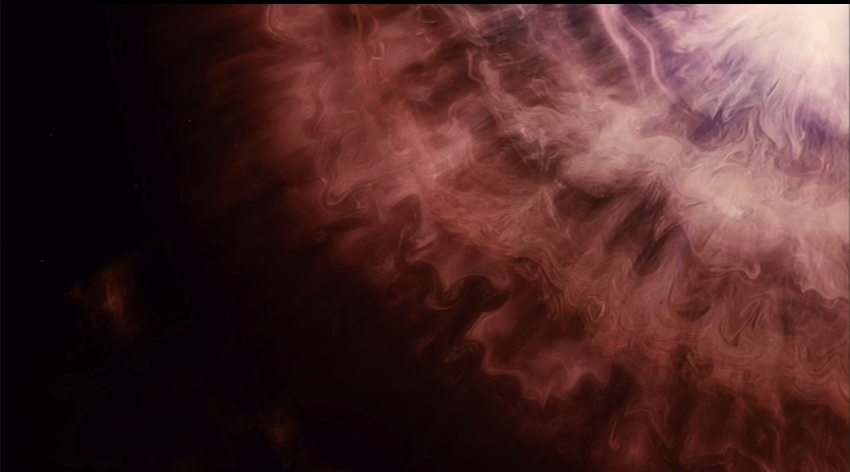
However, instead of continuing the religious symbolism, the sequence suddenly takes on a scientific look with digitally enhanced images of nebulas, Hubble photographs, volcanoes, and early life forms, culminating with the arrival of CGI dinosaurs (see Figure 4). The sequence, then, answers the mother’s question from the perspective of evolutionary biology, suggesting that death is an inextricable part of nature. However, this is an answer only in the dialogical sense; instead of dismissing the spiritual, the incorporation of scientific imagery helps bracket the question of death’s purpose between the two human-centered epistemologies that are operative here: eschatology and thanatology. When interpreted as such, the sequence is an elaborative re-articulation of the film’s title: it simultaneously alludes to both the biblical tree of life, provided as an explanation for the origins of humanity in the Book of Genesis, and to Darwin’s treatise on The Origins of Species. The tension between the eschatological and thanatological explanations for the necessity of death is never resolved in the film. Malick’s 2007 screenplay hints that the montage sequence’s final images—featuring a dinosaur showing compassion to another wounded dinosaur—represent the first signs of maternal love and care among animals, which indicates a return to the theological “way of grace” and the POV of the mother at the end (a suggestion that is once again troubling in terms of its essentialist approach to gender and evolution).
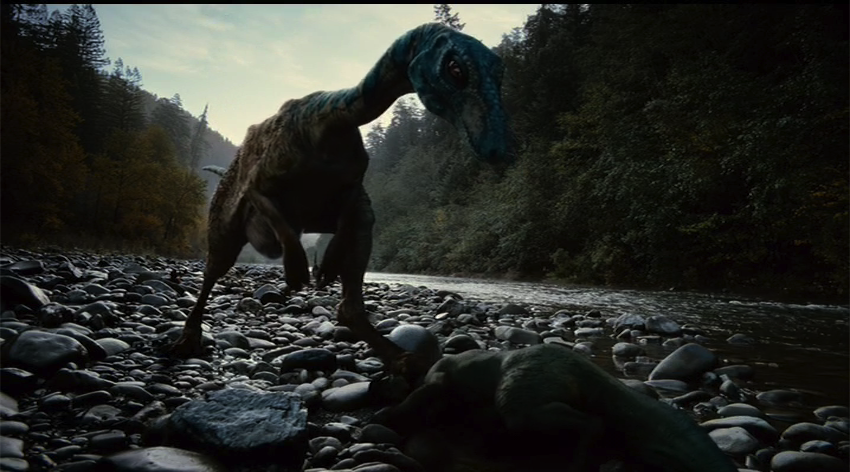
This circular or back-and-forth movement suggests the possibility of a third framework, which might provide an explanation for death: the cosmological. Here, I use the term cosmology not in a sense antithetical to eschatology and thanatology, since these knowledge systems have their own (subject-oriented) cosmologies too, but to suggest a non-correlationist, object-oriented framework that incorporates scientific and metaphysical explanations in order to articulate cosmic relations.
In his discussion of Lars von Trier’s Melancholia (2011), Steven Shaviro speaks of recent films that connect events of cosmic significance—such as the end of the world, extinction, or cosmic catastrophe—with personal experience as “cosmological drama” (“Melancholia”). He ties the interest in cosmological perspectives directly to post-cinematic affect, which he defines in terms of the “structures of feeling” (in Raymond Williams’s term) that have emerged with global capitalism and the artistic/cultural responses to it. Melancholia’s cosmological drama foregrounds the apathy surrounding Western white bourgeois privilege, for example, representing a structure of feeling that Lars von Trier’s work often crystallizes, in which all alternative political options and the future itself appear exhausted in and by capitalism (or capitalism-induced depression).
The Tree of Life is also a cosmological drama in that it connects the familial experience of human loss and mourning with supra-human cosmic realities (such as the big bang and the extinction of species). Although Shaviro himself has mentioned The Tree of Life’s affective import to be much less noteworthy than Melancholia (via his blog and Twitter), the film nevertheless speaks to contemporary (ontological) anxieties related to our knowledge about the possibility of extinction, which brings death and finitude back to the surface of consciousness. These anxieties might be understood as a form of shared affect too, if not as a structure of feeling. (As a filmmaker who often includes references to philosophy in his films, Malick seems better at engaging with ontological questions than with political ones). In other words, it might be less reductive to argue that Malick’s film is a cosmological drama only insofar as cosmology is understood as a speculative approach. It would seem that through cosmology, The Tree of Life intensifies, rather than resolves, the tension between the competing knowledge systems (eschatology and thanatology) that provide an explanation for death.
Whereas this cosmological perspective is focused through images of computer-generated dinosaurs in Tree of Life, Benh Zeitlin’s Beasts of the Southern Wild, dealing with a little girl’s battle for survival amidst rising waters in the Louisiana bayou and her father’s impending death, turns its gaze towards another extinct species: the aurochs (see Figure 5).
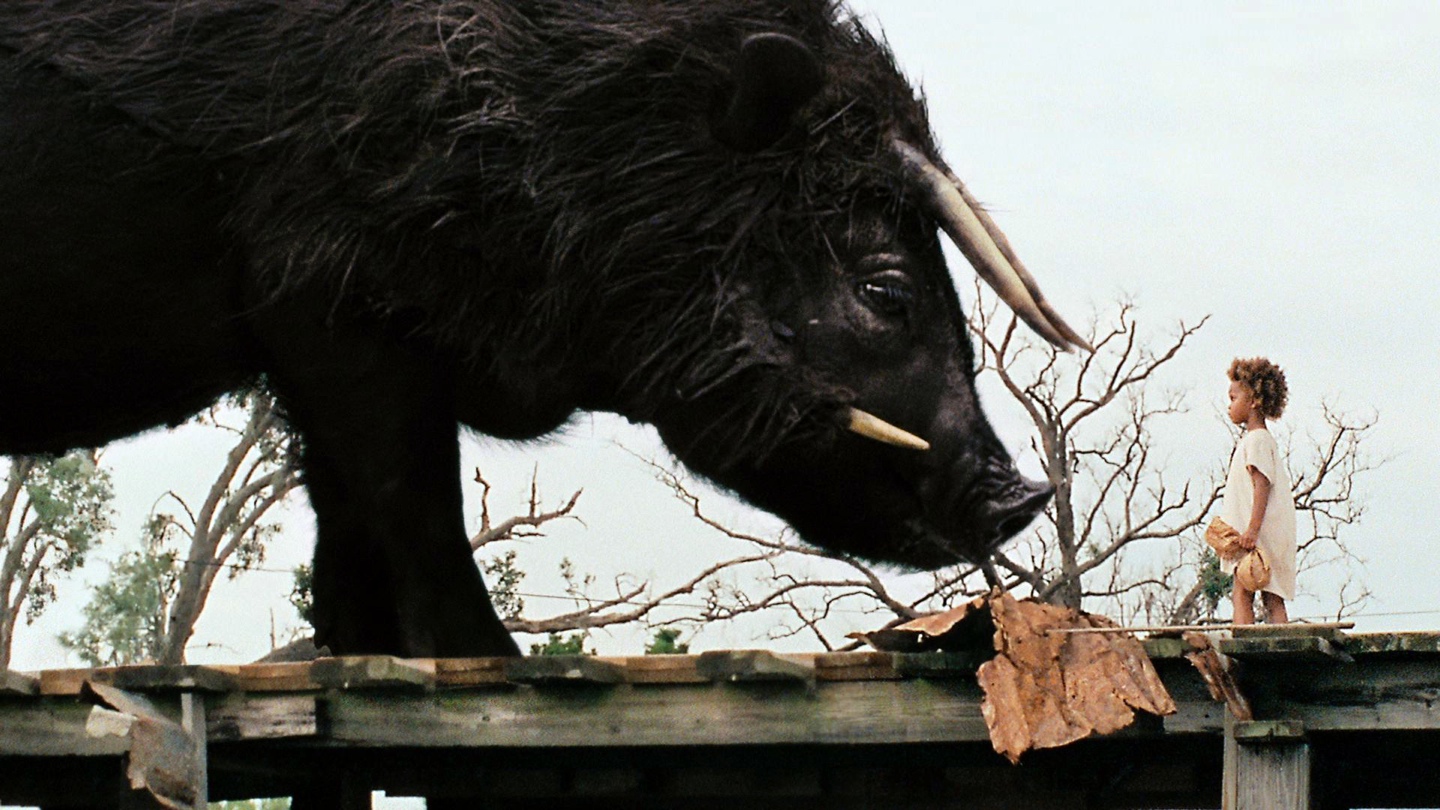
More specifically, the protagonist Hushpuppy (played by Quvenzhané Wallis) establishes a connection between her personal grief and the imagined struggles of a species going extinct in order to cope with the rapidly deteriorating social reality around her. Although the affective logic of the film is different from that of The Tree of Life, since Hushpuppy’s grief not only concerns the past (and the absence of her mother) but is also anticipatory (hers is a proleptic elegy in the sense that she mourns the death of her father and the demise of her community due to climate change before these events have actually happened or fully taken effect), both films reflect a common cosmological or primordigital aesthetic. They do so by featuring characters that try to come to terms with death and human loss by imagining a world in which humanity either hasn’t emerged yet or is threatened by extinction. This primordigital aesthetic, which combines analog and digital realisms to represent realities that belong to non-human as well as pre/post-cinematic temporalities, effectively makes cinema witness to realities without a witness—and is thus suggestive of something akin to the cinematic equivalent of a speculative realist sensibility. Ultimately, the two films establish a parallelism between extinct prehistoric creatures and mournful human characters, pointing to a shift in post-cinema’s approach to our existential temporality.
Mourning, Melancholia, and Damsels in Existential Distress
Cuarón’s reference to evolution at the end of Gravity is quite poignant in this context. In a certain sense, the melancholic narrative that anchors the film’s 3D spectacle bears a striking resemblance to that of The Tree of Life. Much like The Tree of Life’s mother figure Mrs. O’Brien, Gravity’s Ryan Stone is a mother mourning the death of her child and struggling with personal loss—of purpose, faith,[7] and meaning, qualifying the film as another example of cosmological drama without an overt political edge. Stone’s loss gets mapped onto the cosmic battle against (what seems on the surface to be) the onslaught of space debris in a minimal gravity environment,[8] resulting eventually in her return to a consoling vision of evolution. Since space is a topography every bit as nonhuman as that of the primordial Earth, the film’s setting has a sobering and destabilizing effect; it makes human life seem fragile and of relative significance—thus bringing Cuarón’s vision close to Malick’s.[9] However, instead of returning to the universe’s origin, Cuarón embeds the drama of human loss and survival within the broad ecology and slow temporality of evolution that led to the emergence of modern humans (associated, in a quick leap, with the anthropogenic pollution of space), thus pointing more directly to an Anthropocene imaginary marked by geological as well as cosmological time. One can find a relapse to anthropocentricism in this particular choice; yet, what it foregrounds is species-thinking (with evolution reconfiguring humans as only one species among many), therefore having a similar leveling impact on our understanding of humanity’s imprint on Earth.
Stepping back now to look synoptically at the diverse examples considered so far, what we see is three common traits: a new type of post-cinematic aesthetic realism that draws from speculative and realist ontologies; a rising interest in the tropes of extinction, primordiality, and epochal temporalities that have their own ecologies; and, significantly, a shifting of the narrative point of view to female characters. This shift towards female-centered narratives is worthy of further attention here as the evocations of speculative, realist, or object-oriented visions in cinema seem to increasingly rely on women to reflect and anchor contemporary responses to post-gender or species-based articulations of humanity. In doing so, they simultaneously resurrect and reinforce essentialist gender stereotypes and provide a murky terrain, a ground on which a digitally empowered feminism struggles to find a footing (to use the final scene of Gravity as a metaphor). The uncertainty of these attempts seems to stem from post-cinema’s own confusion about the role of gender in imaginations of the Anthropocene.
Femininity in post-cinema is often essentialized and pathologized, especially with regard to the association of women with motherhood, nurturing, caretaking, and grace’s way, as well as with frailty, depression, and hysteric subjectivity—as in Melancholia and Gravity. Melancholia’s sister protagonists show signs of chronic depression and severe psychosomatic effects; Gravity’s Dr. Stone’s debilitating grief-induced depression is coupled with panic attack-like reactions to the satellite debris; The Tree of Life’s Mrs. O’Brien is mostly a pre-feminist era maternal archetype, shot from behind with the breeze wafting the skirt of her iconic period wear; and Beasts of the Southern Wild is populated with a series of nurturing and maternal female characters, including the women Hushpuppy encounters on a floating brothel. From this vantage point, the films appear to project highly regressive and troubling models of femininity, especially in relation to contemporary approaches in feminism, which have since the 1990s shifted their attention from discussions of gender to broader questions about agency and the relationality of bodies and matter.[10] Here, relationality is the key word, since it resists lingering on the binary or exclusive constructions of gender when talking about bodies, focusing instead on affect as something impersonal that runs through both organic and inorganic bodies and matter, highlighting aspects of experience often ignored in frameworks such as speculative realism and object-oriented-ontology (Bennett; Sheldon). Directors such as Alfonso Cuarón and Lars von Trier occasionally gesture in interviews towards a feminist or at least post-masculinist sensitivity by commenting on how female characters allow them to move away from “macho heroism” (Hill), providing the opportunity to focus on affect rather than masculinist techno-capitalism’s ability to save the day in times of societal, economic, and ecological crises. The resulting affect-oriented narratives foregrounding mourning, melancholia, and intentional (yet ambivalently articulated) diversion from male heroics also resonate with certain contemporary models of feminist ethics, such as “post-masculinist rationality,” a type of minimal ethics that acknowledges the uncertainties of things we cannot control instead of masculinist bravery (Zylinska 15), or an “ethic of vulnerability,” which involves a recognition of the agencies of nature and of nonhuman actors to affect us (Hird).
However, such ethical stances in these films get problematically mapped onto women’s bodies or are attributed exclusively to female characters instead of portraying in them a possibility for all. The result of producing narratives in such a gendered matrix is that women in these films appear as new versions of their old stereotyped selves, as damsels in existential distress, or the archetypal “mother as matter,” suggesting a return to the traditional configuration of human-nature relationships through the figure of the mother. For example, the hysteric vulnerability that Cuarón imputes to Sandra Bullock’s character provokes deeply ambivalent reactions: it is both troubling in terms of her portrayal as a familiar damsel in distress figure (now in space), and refreshing as a disavowal of an aggressive environmental politics that responds to ecological threats with destructive technofixes (often associated with masculinity and colonial attitudes).
Melancholia can be contextualized within an aesthetics of vulnerability too, as both the film’s critique of apathetic white bourgeois culture and the two female characters’ eventual conscious resignation to the impending extinction of humanity (as opposed to a futile attempt to fight against it) bear witness to a distinctive passivity and disavowal of masculinist responses. This disavowal is rendered explicit by Claire’s husband’s suicide prior to the planetary collision, whereby the narrative shuts off the bourgeois male subjectivity’s desire to save the day. As Lars von Trier states, “when the earth is ready to crumble between our fingers, whatever we do in the way of heroic conquests or petty family squabbles doesn’t matter” (Carlsen). Interestingly, the filmmaker suggests that the affect of melancholia, as a form of vulnerability, can become a powerful tool vis-à-vis absolute crisis: “depressives and melancholics act more calmly in violent situations, while ‘ordinary, happy’ people are more apt to panic. Melancholics are ready for it. They already know everything is going to hell” (Carlsen). In the final scene of the film, Claire and Justine build a “magic cave” (a makeshift shelter made out of sticks) on a hilltop and calmly await the planetary collision along with Claire’s young son, turning their vulnerability into a form of poetic stillness-in-the-storm. On the one hand, their retreat to a symbolic cave in the final act can be interpreted as another psychic return to the pre-Anthropocene (a kind of paleolithic imaginary reminiscent of the geological temporality of the primordial). However, the critical potential of the scene lies in its suggestion of the possibility to imagine an alternative politics of life in the Anthropocene, albeit one that requires significant interpretive effort by the spectator, since the retreat can also be viewed as a regression to a traditional scene of domesticity with the emphasis on familial bonding. Once again, it is not clear whether the story is simply following a “postfeminist script of retreatism” (Tasker and Negra 269), according to which many contemporary films with female protagonists involve a fantasy of returning to domestic roles, or whether it might point to “transcorporeality”—a form of embodiment in “which the human is always intermeshed with the more-than-human world” (Alaimo 2)—thus transgressing formulaic gender inscriptions.
What can be said about a cinema of Anthropocene womanhood, then, is that it allows room, perhaps mostly unintentionally, for subversive interpretations. Brad Evans and Julian Reid argue that in the age of the Anthropocene, the modern figure for political embodiment, Leviathan, has been displaced by Antigone: a mourning female who embodies the vulnerability and existential terror of our times. In addition to the classical text of Antigone, Evans and Reid suggest Peter Sloterdijk’s atmospheric politics as an influential text for an ecologically sensitive political model of vulnerability. Like Hird, Sloterdijk claims that acting precariously or vulnerably can be a powerful political choice and a responsible form of “weathering” existence (Evans and Reid 124). While not everyone would agree The Tree of Life’s Mrs. O’Brien, Beasts of the Southern Wild’s Hushpuppy, Gravity’s Ryan Stone, and Melancholia’s Claire and Justine could serve as strong models for a politically charged vulnerability in post-cinema (each of them can be critiqued for their formulaic attributes), their mourning and melancholia envelop us and inadvertently deliver to our psyches a 21st-century version of Antigone’s dread, which itself holds promise in these precarious times.
Cinema Knows It
The extinction discourses permeating these film narratives reflect our contemporary anxieties. The proliferation of films that foray into tropes of deep space and time (both pre- and post-Anthropocene) points to the fact that we can now speak of an Anthropocenema proper, which is as much a product of new filmic technologies of post-cinema as it is a portrayal of the catastrophic impacts of human geo-engineering. In his analysis of films including The Edge of Tomorrow (2014) and Only Lovers Left Alive (2013), McKenzie Wark alludes to the emergence of the form, referring to films with narratives about humanity “confronting limits of its own making” and adds:
Cinema knows it. One of the things cinema is there for is to find some kind of objective correlative for feelings that can’t be acknowledged. Maybe cinema is not about desire at all, or even anxiety. Maybe it is about seduction, of turning us aside from unacknowledged feelings, and slipping us into worlds of objects and relations that displace those feelings onto something else. Thus: perhaps all cinema is now about the Anthropocene. It’s all about a sense that this is not a Never Ending Story. (Wark)
In this formulation, a cinema of the Anthropocene is understood as a cinema for the Anthropocene; rather than focusing on the causes of our ecological demise, which often go unmentioned, Anthropocenema brings us face to face with the effects of the so-called Epoch of Man, including the possibility of a total ecosystemic collapse or human self-annihilation. In this context, Wark interprets Gravity as a film “for” the Anthropocene, as a sort of flight simulator for the Anthropocene that imagines how we might survive it. Dr. Ryan finds a way out of disaster through her return to earth and rebirth on the shore. Here, Wark’s take differs from mine in that he does not find a lingering after-effect in the hyperwaste’s haunting offscreen drift or a self-effacing ambiguity in the final evolution sequence. Perhaps one can read Christopher Nolan’s Interstellar (2014) in this fashion too. On the one hand, it serves almost too literally as a flight simulator for the Anthropocene; Matthew McConaughey’s character, NASA pilot Cooper, achieves a masculinist victory over the threat of extinction by successfully exploring exo-planets and securing the survival of humanity. Yet, the haunting image of the species-threatening dust-winds (reminiscent of the iconic Dust Bowl) back on Earth and the deserted planet in the end leave a lingering after-thought that denies total catharsis. But if Wark and I differ on these points, such variation only strengthens the argument that cinema is now producing rich narratives in, of, and for our contemporary geological epoch.
With a somewhat different inflection, Mohammad Salemy sees in the cinema of the Anthropocene a deviation or liberation from 20th-century cinema’s complicity with terminal capitalism:
The 20th century witnessed how human-centered cinema followed and caught up with our older ambition for rapid and accelerated industrialization. Thus the resurrection of cinema and its digital and networked offspring from death must involve saving them from their humanistic essence. Like nature, they need to be rescued from the domain of man and freed from his short-circuited feedback loop that ties every film—if not every piece of media, its beginning, and its end, to humans.
Salemy’s framework is striking in that it also acknowledges cinema’s anxieties over its own possible extinction. A cinema of the Anthropocene has to “resurrect” cinema from a death caused by terminal capitalism and the rapid shifts in technology that impose upon it increasingly accelerated cycles of obsolescence. If cinema was once what relocated the old arts, “leading them out of a bottleneck in which they would otherwise risk extinction” (Casetti), it is now being pushed to the periphery of cultural production or itself relocated by emerging media and networks, risking obsolescence. The waste fantasies in films like Gravity are poignant in this context, as the becoming-waste of a no longer needed satellite—the no longer relevant technology reconfigured as waste, as something other than itself—is a powerful metaphor for the possible future that awaits cinema, thus conjoining ecological and self-reflexive implications. Of course, cinema has always been concerned about its becoming-defunct status vis-a-vis emerging media, as Paul Young demonstrates in his book on “media fantasy films,” The Cinema Dreams Its Rivals. In response to an earlier version of this chapter presented at a conference, Stephen Rust brought up Young’s work and insightfully suggested that if we are to establish a link between waste and post-cinema, then “we might consider that cinema has always been postcinema in its imagination—or, perhaps better . . . that cinema has always been a cinema of waste” (Rust).
Additionally, scholars like Nick Mirzoeff and Janet Walker theorize the aesthetics and representations of the Anthropocene. Mirzoeff looks at the ways in which “the Anthropocene-aesthetic-capitalist complex of modern visuality” has become “deeply embedded in our very sensorium and modern ways of seeing” (213), while Walker takes a media-ecological approach to the cinematic contemplations of petrocultures in films like Dirty Energy and Beasts of the Southern Wild, focusing on the deep waters and wetlands destroyed by oil spillage.[11] The distinct frameworks mentioned above point to the fact that even in its emergent state, Anthropocenema gives us a great deal to think about in terms of the diverse narrative, aesthetic, and political directions it might take in the near future.
At this point, a word of caution might be in order. Although one is tempted to move quickly among various films depicting tropes of primordiality, extinction, or ecological/cosmic realities beyond the human frame, there is a danger in conflating the distinct speculative, accelerationist, and anthropocenematic undertones in them. In an effort to move away from anthropocentric thinking, speculative ontologies often shift their attention to nonhuman temporalities, but such a focus does not always square easily with a critical interest in the impact of the social on ecology, for example (though some speculative thinkers, such as Ian Bogost and Timothy Morton, are more ecologically concerned than others). Accepting the idea that humankind has become the most powerfully destructive geological agent in the contemporary world, akin to the glacial cycles or systems of volcanism in previous epochs, ironically requires putting the human subject back at the center of thought (even if it is viewed as deeply entangled with a universe of objects); such a reorientation sits uncomfortably, at best, with the speculative movement’s priorities (such as foregrounding object-object relations).[12] Similarly, certain Anthropocene-oriented or accelerationist films might be anthropo-centric in ways that do not diminish their potential for forging new relations between bodies, matter, and politics. Therefore, it is important to resist quick labeling and to use these interpretive frameworks as entry points into a more nuanced understanding of post-cinema.
Afterthought: An Aesthetic of Disposal and Drift
As I pointed out at the beginning of this chapter, the techno-industrial waste that terrorizes the astronauts and viewers in Gravity makes another noteworthy appearance in Bong Joon-ho’s much-anticipated CGI spectacle Snowpiercer (2013). Here, techno-industrial waste occupies an ambiguous role: it is both a kind of “opiate of the masses,” lulling the accidental-ice-age generation born on the train into docility, and at the same time, the explosive agent of revolution that eventually destroys the very system that produced it (see Figure 6).
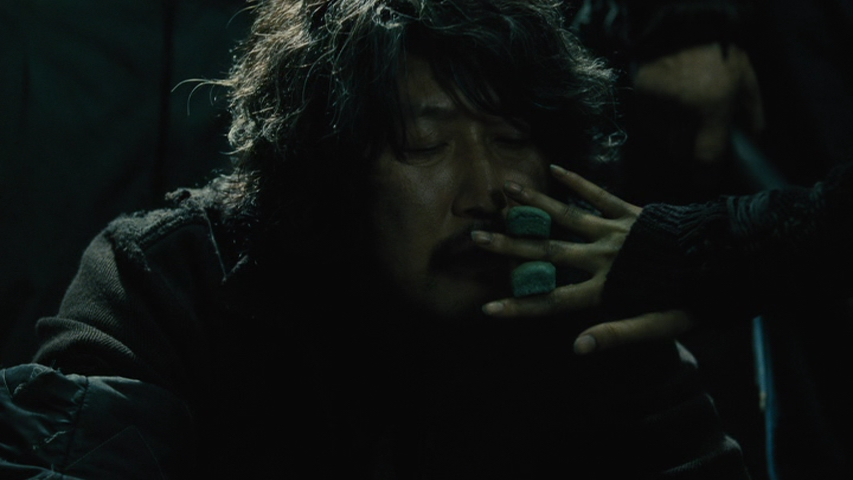
Loosely based on the French graphic novel Le Transperceinage, the film’s mise-en-scène is evocative of techno-industrialism: humanity, or what’s left of it, is tethered to a high-speed train that races ceaselessly around the globe on a circular track, powered by a perpetual-motion engine. The train functions like a carefully bio-engineered miniature ecosystem, the population of which is divided into distinct hierarchical categories, reminiscent of both social Darwinism and Marxist class structures. The upper classes, it would seem, have no intention of trying to find a solution to the technoscience-induced ice age; instead, they merely impose further technofixes to prevent imbalances in the train’s ecosystem, recalling contemporary capitalism’s stopgap responses to global ecological problems. The lower classes, who reside in the tail section of the train, rise up against the oppressive regime, but their attempt to co-opt it eventually fails; the male protagonist Curtis’s heroic idea of taking over the train turns out to have been anticipated all along—programmed, in fact, by the system itself, which regards the deaths occasioned by periodic revolts as an effective means of population control.
What is interesting, in this representation of a failed revolution, is the film’s foregrounding of cyclicality; the narrative starts with a bleak (somewhat Dickensian) sight of humanity in the aftermath of an accident that very nearly brought about the species’ extinction, only to have it go through a crueler decimation in the end. Bong states in an interview that the male protagonist’s central journey “from the dark tail section to the light front section is yet another cycle” in the looping narrative of the film; “when the end and the front are linked, it establishes yet another frustration for the character” (Anders), as he is asked to take over the operation of the train, with its stifling political matrix left intact. In this context, cyclicality points to a parallelism between the mechanism of the train and the crisis logic behind neoliberal capitalism: crisis is not antithetical to the system; rather, it emerges as its modus operandi.
It is not surprising then that the techno-industrial waste has a recurring appearance as well. At the outset, everything on the train seems to be regulated through a delicate system of recycling; nothing goes to waste and everything is produced according to necessity. Yet, this only proves to be a façade; the procedures for waste management include the targeted disposal of people of the underclass, who have no access to food or amenities, while the front section classes are portrayed enjoying the excesses of the system, complete with drug-enhanced rave parties (Figures 7 and 8).
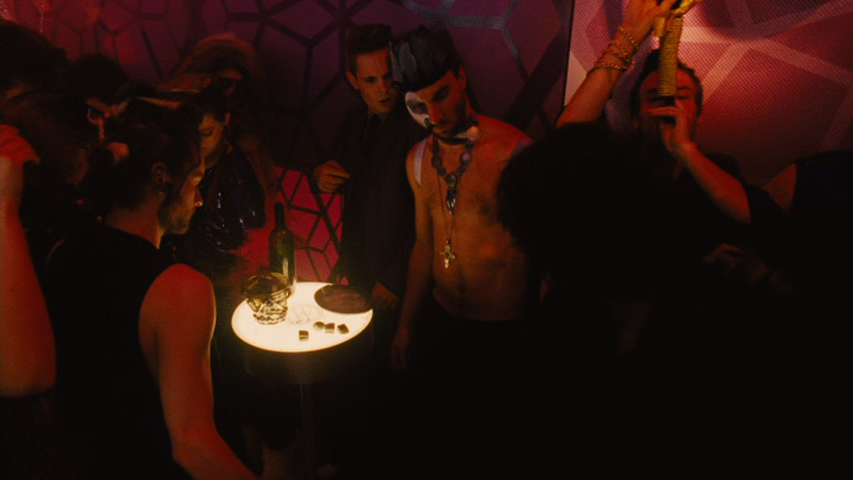
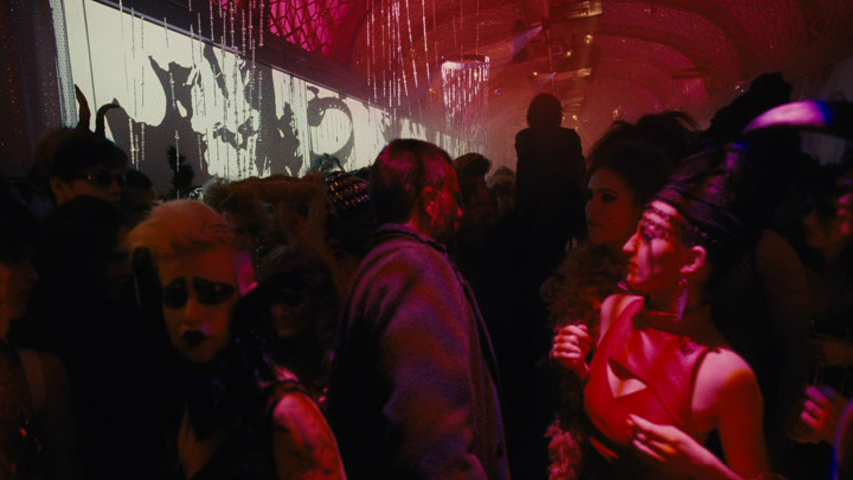
The waste-derived drug pacifies the youth in the front sections (resonating with the contemporary fascination and intoxication of consumer capitalism, which manufactures species-threatening waste on a planetary scale), but it also helps kickstart the revolt in the tail section and ultimately leads to the destruction of the train at the end of the film. Waste is therefore a liminal object and a world-historical event, with the name Kronol evocative of chronos, time or duration. Its lingering or long-lasting presence, much like the satellite waste in Gravity, causes a spatio-temporal disorientation, a hallucinogenic effect that blurs the distinction between what is disposed of and what endures. The becoming-cinematic of waste is the becoming-cinematic of the Anthropocene’s temporality; accordingly, and appropriately, the aesthetic of disposal involved in waste’s cinematic representations leaves the viewer feeling profoundly adrift.
In the final act of the film, the narrative point of view shifts suddenly to a 17-year-old Kronol-addicted Korean girl, Yona, who decides to blow up the train using Kronol as a bomb, to bring about humanity’s second near extinction—leaving her and a 5-year-old boy as the only survivors. Only thus, apparently, is it possible to escape the ineluctable trajectory of the system (the system of the train, of capitalism and social oppression, or of techno-industrial destruction and environmental desolation). The last scene of the film shows the female survivor Yona, standing in front of a burning train, buried in ice and snow, and looking pensively at a polar bear glancing back at her, immediately recognizable as the inevitable victim of the 21st century’s already underway mass extinctions (Figures 9-11).

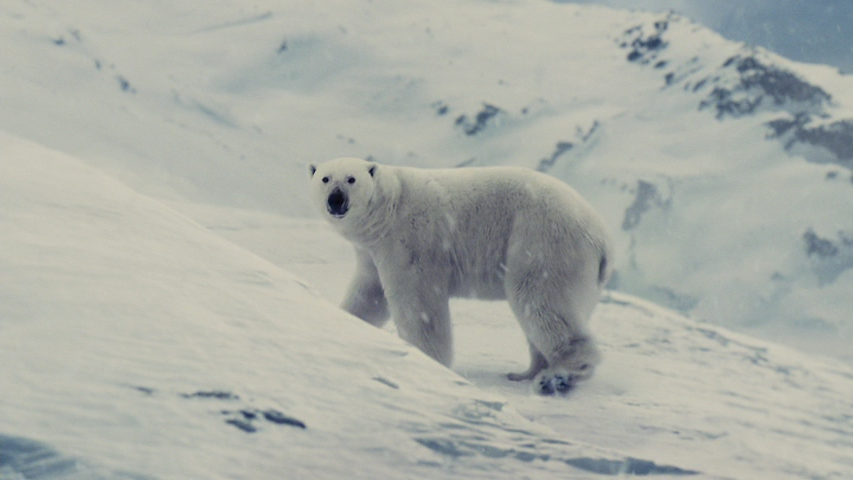
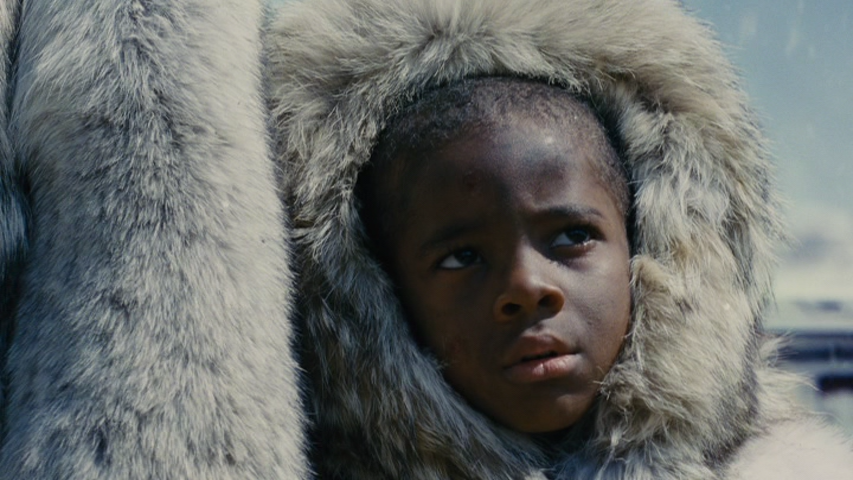
As in several of the films discussed in this chapter, human confrontation with extinct species (whether already extinct, soon-to-go, or about-to-come-back-to-life) is not uncommon in Anthropocenema. However, Snowpiercer hints at a possible reversal in the dynamics of the scenario, which evokes cosmic stakes but often focuses attention or affective energy on the human as the species that must act, or mourn, or walk away.
In Yona’s calm exchange of glances with the polar bear, that is, it is possible to detect the instant recognition of humanity’s imminent extinction and the other species’ survival, thus reversing the roles implied, presumably, in contemporary environmentalists’ use of the polar bear as the poster child for global warming. The scene suggests an acknowledgement that evolution might continue without humans. Once the ice melts, the world and life might start anew, setting itself a course of its own. Or, alternately, the survivors of the train explosion (both notably nonwhite and marginalized in the Western context in terms of gender, race, and age) might manage to reboot humanity with an entirely different kind of civilization. As Dana Luciano suggests, the inhuman humanism of the Anthropocene cannot be attributed to all humans: “The contradiction that some have seen in the name of the proposed epoch—that the ‘Anthropocene’ was not brought about by all members of the species it names—is precisely the problem it is now up to us to solve.” Perhaps cinema can speak to the histories of power that have suppressed humanisms that are still worthy of salvaging. Or, perhaps, the next leap for Anthropocenema will be to stretch its already expanded temporal and spatial boundaries even further, and to project visions of this world entirely-without-humans.
Works Cited
Alaimo, Stacy, and Susan Hekman. Material Feminisms. Bloomington: Indiana UP, 2007. Print.
Alaimo, Stacy. Bodily Natures: Science, Environment, and the Material Self. Bloomington: Indiana UP, 2010. Print.
Anders, Charlie Jane. “Bong Joon-ho Explains Why Snowpiercer’s Violence is so ‘Explosive.’” 25 June 2014. io9. 20 Dec. 2014. Web. <http://io9.com/how-bong-joon-ho-turned-snowpiercer-into-your-worst-dys-1596079364>.
Barad, Karen. “Posthumanist Performativity: Toward an Understanding of How Matter Comes to Matter.” Signs 28.3 (2003): 801-31. Print.
Barrett, Estelle, and Barbara Bolt. Carnal Knowledge: Towards a ‘New Materialism’ through the Arts. London: I.B. Tauris, 2013. Print.
Bennett, Jane. Vibrant Matter: A Political Ecology of Things. Durham: Duke UP, 2010. Print.
Brassier, Ray. Nihil Unbound: Enlightenment and Extinction. Basingstoke: Palgrave-Macmillan, 2010. Print.
Bryant, Levi R., Nick Srnicek, and Graham Harman. The Speculative Turn: Continental Materialism and Realism. Melbourne: re.press, 2011. Print.
Carlsen, Juul. “The Only Redeeming Factor is the World Ending.” 4 May 2011. Danish Film Institute. 1 Mar. 2015. Web. <http://www.dfi.dk/Service/English/News-and-publications/FILM-Magazine/Artikler-fra-tidsskriftet-FILM/72/The-Only-Redeeming-Factor-is-the-World-Ending.aspx>.
Casetti, Francesco. “The Relocation of Cinema.” 22 Nov. 2012. NECSUS: The European Journal of Media Studies. 15 Mar. 2015. Web. <http://www.necsus-ejms.org/the-relocation-of-cinema/>. Revised version in this volume.
Colebrook, Claire. Death of the PostHuman: Essays on Extinction, Vol. 1. London: Open Humanities P, 2014. E-book.
Coole, Diana, and Samantha Frost. New Materialisms: Ontology, Agency, and Politics. Durham: Duke UP, 2010. Print.
Evans, Brad, and Julian Reid. Resilient Life: The Art of Living Dangerously. Cambridge: Polity P, 2014. Print.
Gabrys, Jennifer. Digital Rubbish: A Natural History of Electronics. Ann Arbor: U of Michigan P, 2011. Print.
Harman, Graham. Guerilla Metaphysics: Phenomenology and the Carpentry of Things. Chicago: Open Court, 2005. Print.
Hill, Logan. “Stepping Into the Void: The Magic of ‘Gravity.’” 25 Sept. 2013. Rolling Stone. 1 Mar. 2015. Web. <http://www.rollingstone.com/movies/news/stepping-into-the-void-the-magic-of-gravity-20130925>.
Hird, Myra. “Waste, Landfills, and an Environmental Ethic of Vulnerability.” Ethics and the Environment 18.1 (2013): 105-24. Print.
Kara, Selmin. “Beasts of the Digital Wild: Primordigital Cinema and the Question of Origins.” SEQUENCE: Serial Studies in Media, Film and Music 1.4 (2014). Web. <http://reframe.sussex.ac.uk/sequence1/1-4-primordigital-cinema/>.
Latour, Bruno. “Agency at the Time of the Anthropocene.” New Literary History 45.1 (2014): 1-18. Print.
Luciano, Dana. “The Inhuman Anthropocene.” 22 Mar. 2015. Avidly: Los Angeles Review of Books. 23 Mar. 2015. Web. <http://avidly.lareviewofbooks.org/2015/03/22/the-inhuman-anthropocene/>.
Lynch, Kevin. Wasting Away – An Exploration of Waste: What It Is, How It Happens, Why We Fear It, How To Do It Well. Ed. Michael Southworth. San Francisco: Random House, 1991. Print.
Meillassoux, Quentin. After Finitude: An Essay on the Necessity of Contingency. London: Continuum, 2009. Print.
Mirzoeff, Nicholas. “Visualizing the Anthropocene.” Public Culture 26.2 (2014): 213-32. Print.
Morton, Timothy. Hyperobjects: Philosophy and Ecology after the End of the World. Minneapolis: U of Minnesota P, 2013. Print.
O’Callaghan, Jonathan. “Gravity: The Science behind the Movie.” 1 Oct. 2013. All About Space. Ed. Ben Biggs. Imagine Publishing, 4 Mar. 2015. Web. <http://www.spaceanswers.com/space-exploration/gravity-the-science-behind-the-movie/>.
Salemy, Mohammad. “After Anthropocinema.” 15 July 2014. The Brooklyn Rail: Critical Perspectives on Arts, Politics, and Culture. 20 Dec. 2014. Web. <http://www.brooklynrail.org/2014/07/criticspage/after-anthropocinema>.
Schwartz, Evan I. “The Looming Space Junk Crisis: It’s Time to Take Out the Trash.” 24 May 2010. WIRED. 18 Feb. 2015. Web. <http://www.wired.com/2010/05/ff_space_junk/>.
Shaviro, Steven. “Accelerationist Aesthetics: Necessary Inefficiency in Times of Real Subsumption.” E-Flux 46 (2013). Web. <http://www.e-flux.com/journal/accelerationist-aesthetics-necessary-inefficiency-in-times-of-real-subsumption/>.
—. “Melancholia or, The Romantic Anti-Sublime.” SEQUENCE: Serial Studies in Media, Film and Music 1.1 (2012). Web. <http://reframe.sussex.ac.uk/sequence1/1-1-melancholia-or-the-romantic-anti-sublime/>.
—. The Universe of Things: On Speculative Realism. Minneapolis: U of Minnesota P, 2014. Print.
Sheldon, Rebekah. “Form / Matter / Chora: Object-Oriented Ontology and Feminist New Materialism.” The Nonhuman Turn. Ed. Richard Grusin. Minneapolis: U Of Minnesota P, 2015. 193-222. Print.
Steffen, Will, Jacques Grinevald, Paul Crutzen, and John McNeill. “The Anthropocene: Conceptual and Historical Perspectives.” Philosophical Transactions A 369.1938 (2011): 842-67. Print.
Tasker, Yvonne, and Diane Negra. Interrogating Postfeminism: Gender and the Politics of Popular Culture. Durham: Duke UP, 2007. Print.
Thacker, Eugene. In the Dust of this Planet: Horror of Philosophy Vol. 1. Winchester: Zero, 2011. Print.
Viney, William. Waste: A Philosophy of Things. New York: Bloomsbury, 2014. Print.
Wark, McKenzie. “Anthropo{mise-en-s}cène.” 10 Dec. 2014. Public Seminar Commons. 20 Dec. 2014. Web. <http://www.publicseminar.org/2014/12/anthropomise-en-scene/#.VQSvTFr-38l>.
Woerner, Meredith. “Gravity’s Ending Holds a Deeper Meaning, Says Alfonso Cuaron.” 08 October 2013. io9. Gawker Media, 1 Mar. 2015. Web. <http://io9.gizmodo.com/gravitys-ending-holds-a-deeper-meaning-says-alfonso-c-1442690788>.
Notes
[1] In Timothy Morton’s formulation, hyperobjects refer to “things that are massively distributed in time and space relative to humans” (1), including things of the cosmic and natural order, such as black holes, the biosphere, or a vast oil field, as well as of social origin, such as the long-lasting materials used in human products, like plastic and Styrofoam, that outscale and outlast us, eventually turning into species-threatening waste.
[2] In 2009, the syndrome reportedly made its debut when two satellites crashed over the Siberian Tundra, arguably turning Kessler’s theory into a reality (Schwartz).
[3] The script of the film also describes the scene in similar words: “She drags herself from the water, like the first amphibious life form crawling out of the primordial soup onto land.”
[4] It is worth mentioning here that evolution and waste elimination are first and foremost biological processes, related to life. However, by staging the narrative within the vast spatiotemporal reach of cosmic space and technological progress, the film establishes a link among not only biological but also industrial and geological processes—recalling the material relations articulated in the concept of the Anthropocene.
[5] Meillassoux argues that when science makes hypothetical statements about the nature or origins of the universe, philosophers need to take these not just as assumptions without a referent or verifiable object but as a form of reality: “either this statement has a realist sense, and only a realist sense, or it has no sense at all” (17).
[6] Meillassoux’s After Finitude inaugurated the movement by setting primordiality, or “ancestrality,” as he puts it, as the benchmark for our understanding of the role of humanity or philosophy in the world, and Ray Brasier’s Nihil Unbound argued that one could not think about the question of origins without speculating about the broader trajectory of matter, namely, the trope of extinction.
[7] Cuarón, like Malick, does not shy away from incorporating theology into his science-driven narratives, making ample references to religious metaphors and archetypal themes like rebirth.
[8] Notably, the geostationary satellite orbit zone does not lack gravity altogether.
[9] The two films also share the same DP, Emmanuel Lubezki, who used to be noted for being one of the living masters of analog cinematography and its humanist aesthetic realism, yet seems to have now become the go-to figure for projects that blend analog photographic realism with cosmic-scale digital spectacle. For more on Cuarón and Lubezki, see Bruce Isaacs’s contribution to this volume.
[10] One can think here of the various iterations of ecofeminism as well as feminist new materialisms and object-oriented, post-humanist, or non-humanist feminisms that have gained popularity in recent years (see Sheldon; Barrett and Bolt; Coole and Frost; Bennett; Alaimo and Hekman; Barad).
[11] At the 2015 Society for Cinema and Media Studies Conference in Montreal, Walker presented her research on this topic, alongside a version of the present chapter, as part of a panel titled “Cinema in/of the Anthropocene.”
[12] Though perhaps the speculative cosmology of Alfred North Whitehead, which Steven Shaviro has recently put into dialogue with speculative realism and object-oriented ontology in particular, can better accommodate both sides of the equation. See Shaviro, Universe.
Selmin Kara is an Assistant Professor of Film and New Media at OCAD University. She has critical interests in digital aesthetics and tropes related to the Anthropocene and extinction in cinema as well as the use of sound and new technologies in contemporary documentary. Selmin is the co-editor of Contemporary Documentary and her work has also appeared or is forthcoming in Studies in Documentary Film, Poiesis, the Oxford Handbook of Sound and Image in Digital Media, Music and Sound in Nonfiction Film, and The Philosophy of Documentary Film.
Selmin Kara, “Anthropocenema: Cinema in the Age of Mass Extinctions,” in Denson and Leyda (eds), Post-Cinema: Theorizing 21st-Century Film (Falmer: REFRAME Books, 2016). Web. <https://reframe.sussex.ac.uk/post-cinema/6-2-kara/>. ISBN 978-0-9931996-2-2 (online)
